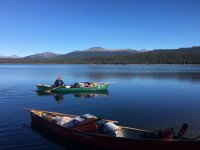I took my 15' center seat down the Allagash last year, and felt I had limited control especially when I went to my knees to the point I just stayed in the seat on the lower river.
This year in Algonquin battling the wind I was glad I was sitting in the bow seat facing the stern. I felt I had a lot more control in the large waves and when gusts tried to blow the bow out of the wind.
This year in Algonquin battling the wind I was glad I was sitting in the bow seat facing the stern. I felt I had a lot more control in the large waves and when gusts tried to blow the bow out of the wind.

